2014年秋季新目标英语九年级Unit2 Section B(3a-3b)教案
- 格式:doc
- 大小:85.50 KB
- 文档页数:3

九年级英语Section A 2 (3a-3b)教案Step 1 RevisionGive the students some pictures, then let them talk about:How do you study English?I study by ______________.Step 2 Reading1. Warming upLook at the picture on page 3, then let the students talk about:The girl is Wei Fen. What is she doing? Can you guess how she studiesEnglish ?2. ReadingFinish 3a: Read the passage about Wei Fen and answer the questions.1) Why did Wei Fen find it difficult to learn English?2) What did she do in English class?3) What is the secret to language learning?secret n. 秘密; 秘诀adj. 秘密的; 保密的Answers:1) The teacher spoke too quickly and Weifen did not understand her most of the time, but she was afraid to ask questions of her poor pronunciation.2) She hid behind her textbook and never said anything.3) For Wei Fen, the secret to language learning is listening to something interesting.Finish 3b: Complete the sentences with what Wei Fen learned from watching movies. Use words and phrases from the passage.1) I can understand the meaning by watching their ______________ and the__________ on their faces.2) I can get the meaning by listening for just the _________.3) My pronunciation improved by listening to the _____________ in Englishmovies.4) I learned ______ sentences like “It’s a piece of cake”by watching themovies.5) I can find the meaning of the new words by looking them up in a _______.Answers: body language expressions key wordsconversations useful dictionaryexpression n. 表情; 表示; 表达方式九年级英语Section A 2 (3a-3b)教案Step 3 Language points1. Why did Wei Fen find it difficult to learn English?find it difficult/hard to do sth. 发现做某事很困难【find用法归纳】find sb. doing sth. 发现某人做某事find it + adj. + to do sth. 发现做某事很……find it + adj. to do sth.中的it是形式宾语, adj.做宾补, to do sth.是真正的宾语。





Teaching plan for a read-to –write lessonUnit 2 Section B (3a-3b)(Go for it for Grade 9)海口一中张力Language goals: Describe life changes one has while growing upLearning Objectives:I.Knowledge and skills1.Master the structures: used to /didn’t use to2.Learn to extract useful information from the text.3. Learn to write with the language learned from the reading text.II.Teaching Method1.Scaffold the students by activating their thinking and offering modeltexts.2.Guide the students to build the awareness of language features by studying the language form.III.Important and Difficult Points in TeachingUsed to do/didn’t use toUsing the simple past tense to describe the pastUsing the simple present tense to describe nowIV. Teaching aids:1.Reading texts2.PPTStep I Pre-reading ( 6 mins )1. Show two pictures of a girl, one taken when she was young, and theother taken this year. Ask the students to look at the pictures and describe the changes of her look. Instruct the students to use structures “used to/did n’t use to ” while describing the girl of her younger time. ( 2 mins )2. Ask the students to guess why the girl looks happier when she wasyoung. Also emphasize the use of structure “used to/didn’t use to” while 3.Teacher states: changes have to take place while we are growing up.Different people may have different changes in life. Sometimes changes cause problems. Today, we will meet a girl called Rose Tang. She is in high school now. What problems does she have? Turn to Page 14 and here is her story in 3a.(1 min )Step II While-reading ( 15 mins )1. Ask the students to skim the story in 3a and tell what Rose Tang’sbiggest problem is. ( 1 min )2. Check the answer. ( 1 min )3. Ask the students to scan the story and find out what Rose tang used todo and what she does now. Fill the information in the chart below the story. ( 4 mins )4. Check answers, reminding them or the use of the structure “used to”when needed. ( 2 mins )Rose Tang then Rose Tang nowused to have much timeused to spend a lot of time playing games with friendsused to watch TV or chat with her grandmother in the eveningused to go to concerts with her father doesn’t have much time has no time for playing gameshas to studyhas no time for concerts5. By comparing Rose tang’s past and current situation, guide the students to generalize that Rose tang’s life has changed when she grows older and the changes bring her many problems. She is not as happy as she was. ( 1 min )6. Elicit the question: Do all the changes cause problems?7. Present the passage of another girl “How I have changed”. Ask students to read it and see if there are any good changes about the girl. ( 2 mins )How I’ve changedMy life has changed a lot in the last few years.My daily life is different and I used to likedifferent things when I was young. Forexample, I didn’t use to like tests. Now, Idon’t mind them. I used to hate gym. Nowit’s my favorite class. I used to play everyday after school. Now, I study all the time. Iused to walk to school. Now, I have to takea bus.8. Check the answers. ( 1 min )9. Guide the students to generalize the language features presented in the description of changes, using sentences from the text. ( 2 mins )I didn’t use to like tests. Now, I don’t mind them.I used to hate gym. Now it is my favorite class.I used to play every day Now, I study all the time.after school.I used to walk to school. Now, I have to take a bus.Past NowSimple past tense(一般过去时)Simple present tense (一般现在时)used to/didn’t use to10. Teacher states: From the stories we learned today, we can see thereare many changes while we are growing up. Some changes cause problems and some make us feel happy. Would you like to share some changes about your life since primary school?Step III Post-reading ( 19 mins )1.Ask students to tell one of their changes in the past few years orally.2. Select several students randomly to share their sentences, making sure they use the correct language and grammar.3. Ask the students to write a short passage about how their life has changed since primary school. Hints and time limit are given.Before the students start to write, guide them to structure the writing by referring to the two passages in the textbook. ( 15 mins )Text structureTitle________Opening–Brief statement(My life has changed…)Body part–ChangesConclusion—Personal comment4. When time is up, choose one or two writing randomly and do jointediting in the class. ( 4 mins )AssignmentExchange the writing in pairs. Read your partner’s writing and give response.。